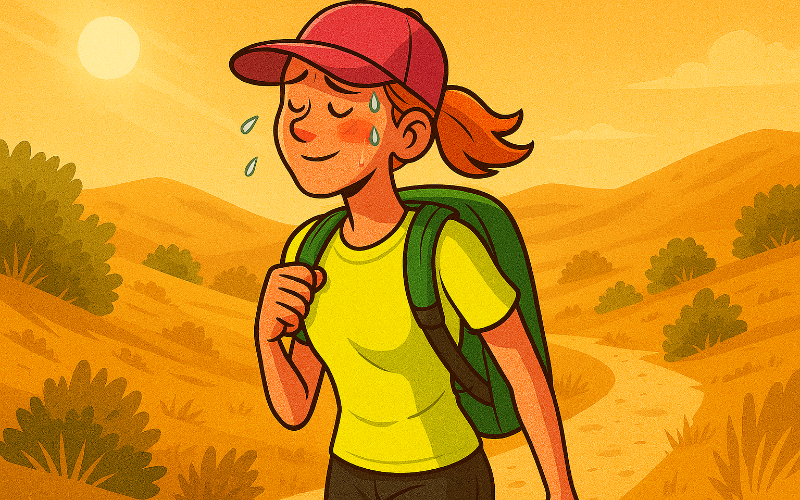Some important facts:
- Spain’s solar noon (when the sun is highest) is around 2pm, not 12 noon – so the heat builds throughout the afternoon.
- If you stop passing urine, that’s an early sign of heat exhaustion. Your body is redirecting fluids to protect vital organs.
- If you stop sweating, you’re in dangerous territory.
- Light-headedness and dizziness are red flags...the next step is passing out.
- Hydration is not optional. Drink regularly – even if you don’t feel thirsty.
- DO NOT UNDERESTIMATE the heat in Spain.
Walking Temperatures in Spain:
What’s Safe, What’s Sensible, and When to Sack It Off
Below is a straightforward guide to what I think the different temperature feel like when walking here in Spain, and when it’s time to swap your walking boots for a shady terrace and a cold drink.... maybe a vino (with ice of course, to keep hydrated!). Just my personal take, not medical advice. Based on my years of walking here.
< 20 °C (< 68 °F)
- Perfect for walking, especially in spring and early autumn.
- Feels fresh but not cold.
- Light layers or a long-sleeved top might be ideal at 15 °C.
- Pain risk is low, unless you’ve got joint issues triggered by cooler air.
- Early morning walkers rejoice, this range is where discipline meets pleasure.
21 °C–25 °C (69 °F–77 °F)
- Still ideal, but shade and hydration become more important.
- Muscles stay warm, joints feel loose.
- Discomfort is still minimal, but if you’re walking in full sun, you’ll feel it.
- Time your walk: mornings or evenings start to look smarter.
26 °C–30 °C (79 °F–86 °F)
- We’re entering caution territory, especially with humidity or sun exposure.
- Sweating increases, so hydration and shade become non-negotiable.
- People with arthritis or chronic pain might start feeling symptoms flare.
- Sunburn, heat rash, fatigue… all are lurking if you’re not covered and prepared.
- Get the walk done early or delay until the evening.
31 °C–35 °C (88 °F–95 °F)
- Are you mad!?
- Pain sensitivity increases. You’re losing fluid fast. Joints and muscles are more prone to strain or cramps.
- Your body is working overtime to cool down, so you might feel dizzy, heavy-legged, or unusually exhausted.
- High UV risk. Skin burns faster. Headaches and nausea more likely.
- At this point, it’s not about being tough, it’s about being smart.
> 36 °C ( > 104 °F)
- STOP!!!! This is unsafe !!!!!!
- Walking in this heat can lead to heat exhaustion or heatstroke, even in the shade.
- Your skin, lungs, and muscles are all under stress.
- If you’ve got any kind of pain condition, like arthritis, fibromyalgia, old injuries, you may find them screaming at you.
- Hydration alone isn’t enough. You need to avoid exertion during these temps, full stop.
So, what’s the verdict?
| Temp Range | Comfort | Pain/Discomfort | Recommendation |
|---|---|---|---|
| 15–20 °C | Excellent | Minimal | Go for it – prime time |
| 21–25 °C | Good | Low | Ideal, especially mornings |
| 26–30 °C | Moderate | Medium | Shade, hydration, and timing is vital |
| 31–35 °C | Poor | High | Early morning only & very short walks |
| 36–40 °C | Very Poor | Very High | Not recommended – skip it |
How can you stay cool if you are out and about walking?
Even if it's a short stroll into the village, or off to the shops to indulge in their air con, you’ll want to get smart. Here is my guide on How to Keep Cool Walking in Spain – your essential guide to surviving the sizzle with practical tips on hydration, gear, routes, and body care when temperatures soar.
As I said above — I’m not a medical expert. These are just my thoughts and experiences from living and walking in Spain year-round. If you’ve got a different take or extra advice, I’d love to hear it in the comments. Let’s help each other stay safe and keep walking smart.



.jpg)
